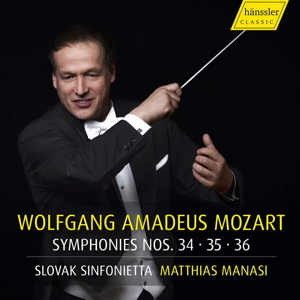
Wolfgang Amadeus Mozart (1756-1791)
Symphony No. 34 in C major, K338 (1780)
Symphony No. 35 in D major, K385 ‘Haffner’ (1782)
Symphony No. 36 in C major, K425 ‘Linz’ (1783)
Slovak Sinfonietta Žilina/Matthias Manasi
rec. 2002 Philharmonie, Žilina, Slovakia
Hänssler Classic HC22078 [74]
The Slovak Sinfonietta Žilina under Matthias Manasi performs three much-admired symphonies, Nos. 34, 35 ‘Haffner’ and 36 ‘Linz’, written by Mozart during the years 1780-83, a time that followed one of the most significant periods of his life.
In March 1778, Mozart had been eager to escape the discontent of working as court violinist for the Prince-Archbishop Hieronymus von Colloredo, ruler of Salzburg. Resigning his position, Mozart travelled with his mother Anna Maria to Paris, during which trip his mother’s health seriously deteriorated and she died after a short illness. Mozart returned to Salzburg in January 1779 and was re-engaged by Colloredo. He was court organist with improved employment terms, but was still disenchanted by the limitations of his court duties. Undoubtedly a changed and chastened man, Mozart now began to write symphonies of a richer, more personal character and in which it is possible to see evidence of the greatness still to come.
Symphony No. 34 in C major, K338 was the final symphony Mozart composed during his Salzburg years. Cast in three movements, it is one of Mozart’s most jubilant and charming symphonies. There is no Minuet movement, but there still exists in the manuscript a fragment of a torn out Minuet. Professor Neal Zaslaw describes the Finale: Allegro vivace as a ‘large jig in sonata form’. Manasi’s performance is especially strong here, giving a foot-tapping ebullience to the Italianate dance rhythms.
Mozart married singer Constanze Weber in St. Stephen’s Cathedral, Vienna, in August 1782, the year he completed his Symphony No. 35 in D major, K385. Known as the ‘Haffner’, it was commissioned by the prominent Haffner family of Salzburg on the occasion of the ennoblement of Sigmund Haffner Jnr. This festive work was successfully performed at the prestigious ‘Wiener Akademien’, attended by Emperor Joseph I, in March 1783 I. The second movement Andante here is particularly successful; Manasi shapes the glorious melodies elegantly, evoking the serenity of an evening serenade.
After visiting Salzburg, Mozart and Constanze stopped off at Linz where he hurriedly arranged a concert. Having no orchestral scores with him, Mozart wrote a new symphony with lightning speed in just a few days and the Symphony No. 36 in C major, K425 became known as the ‘Linz’. A four-movement score containing an abundance of brief ideas, it has a vigorous, Haydnesque quality. A highlight is Manasi confident conducting of the Finale,a fleet Presto of sunny disposition that increases in agitation and is full of wit.
Founded in 1974, the twenty-five strong Slovak Sinfonietta Žilina has been described as ‘Slovakia’s only Classical period chamber orchestra’. Under Matthias Manasi, it performs well, creating a broad range of tone colour from its modern instruments. Nonetheless, there is some sluggish playing where swifter tempi are required and a need for greater crispness and vitality. The sound quality is satisfactory .
Manasi and the Slovak Sinfonietta play with sincerity – but the competition is fierce. There are plenty of options for more recommendable recordings of these three Mozart symphonies, especially the ‘Haffner’ and ‘Linz’. My first choices are the splendidly played accounts on modern instruments conducted by Nikolaus Harnoncourt with the Royal Concertgebouw Orchestra, recorded in 1980-91 and included in the eight CD set ‘Symphonies – 250th Anniversary Edition’ on Warner. Leading the period-instrument orchestras, are Franz Brüggen’s accounts with the Orchestra of the Eighteenth Century. My recordings of these symphonies form part of Brüggen’s eleven CD set ‘Brüggen conducts Mozart,’ recorded live in 1980-93, a highly recommendable collection on Decca. In the ‘Haffner’ and ‘Linz’ symphonies if I’m looking for upbeat accounts with an abundance of vivacity, I recommend Leonard Bernstein conducting the Vienna Philharmonic recorded in 1984 on Deutsche Grammophon.
Michael Cookson
Previous review: Michael Greenhalgh (July 2023)
Help us financially by purchasing from





















